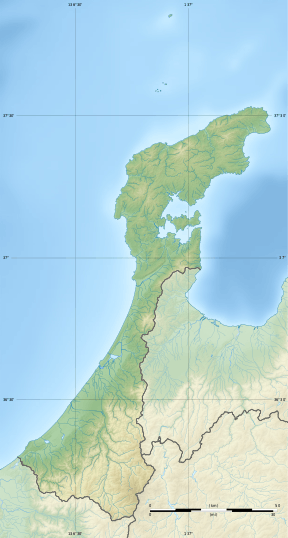Suematsu temple ruins
Suematsu temple ruins (末松廃寺跡) is an archaeological site with the ruins of a Hakuho period Buddhist temple located in what is now the city of Nonoichi, Ishikawa, Japan. The temple no longer exists, but the temple grounds were designated as a National Historic Site by the Japanese government in 1939. [1]
| Suematsu temple ruins | |
|---|---|
末松廃寺跡 | |
| Religion | |
| Affiliation | Buddhist |
| Status | ruins |
| Location | |
| Location | Nonoichi, Ishikawa |
| Country | Japan |
 Shown within Ishikawa Prefecture  Suematsu temple ruins (Japan) | |
| Geographic coordinates | 36°30′29″N 136°35′23″E |
History
The temple site is located in a paddy field in the Suematsu neighbourhood of what is now the city of Nonoichi, near the delta of the Tedori River. The actual name of the temple is unknown, and it does not appear in historical records, so the temple is named "Suematsu Haiji" after the location. From the Edo period, farmers uncovered a very large foundation stone, called the "Karato stone" and many fragments of roof tiles and pottery in the area, so the presence of a ruined temple what known for a long time. A Karato stone is the stone which supports the core pillar at the centre of a pagoda, and from the size of the stone unearthed, it is thought that this pagoda must have been very large, perhaps a seven-story tower. The clan who built the temple is thought to be the "Michi-no-kimi", who ruled the northern portion of Kaga Province during the Hakuho period; however, the roof tiles from the temple came from what is now the city of Nomi, Ishikawa, which was under the control of the Takarabe Miyatsuko.
The site was excavated from 1867-1968, and the base of the pagoda (measuring 10.8 meters square) was found. The foundation of the Kondo measuring 20 x 18 meters was also discovered, indicating that the temple had an east-west scale of 80 meters; however its extent to the north-south is unknown, and the foundation of the gate or other structures remain to be discovered. From the style of roof tiles and some coins discovered on site, it is estimated that the temple was once rebuilt in the late Heian period before falling completely into ruins.
The site is now a public park noted for its cherry blossoms.
References
- "末松廃寺跡" (in Japanese). Agency for Cultural Affairs.
External links
- Ishikawa Prefectural site (in Japanese)
- Nonoichi City site (in Japanese)